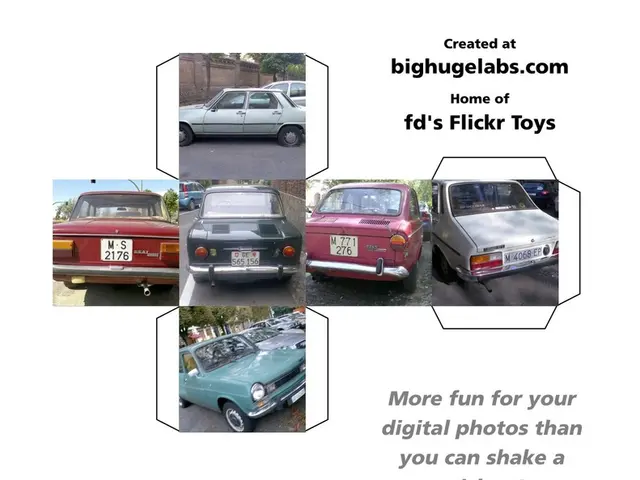Electric vehicle manufacturers aiming to create an identical experience to petrol cars in terms of sound, feel, and operation - but does the consumer end up deceived?
Electric vehicle (EV) manufacturers are stepping up their game to bring back the emotional connection with vehicles that petrolheads love so much – the sound of an engine roaring. For these car enthusiasts, the silence of EVs is the most significant disadvantage, and manufacturers are seizing this as an opportunity.
One of the latest carmakers to invest in sound design is BMW, which recently launched its 'HypersonX' sound technology for its upcoming electric Vision Neue Klasse models. This innovative, immersive soundscape consists of 43 sound signals, tailored to different driving modes for added realism. BMW focuses on precision, warmth, and lightness to create an emotional bond between driver and vehicle [1].
Porsche was one of the pioneers in electric car "engine" noise. Its Porsche Electric Sport Sound was introduced with the Taycan in 2019. This system skillfully composes and tailors tones based on the car's personality and status, prioritizing emotive sounds that harmonize with the vehicle's movements [2].
Another standout example is Hyundai’s Ioniq 5 N, which arrived with the innovative N Active Sound+ in 2023. This state-of-the-art system mimics a combustion engine, offering a sonic reference point and incorporating petrol-fuelled exhaust noises. Users can choose from three sound styles – Ignition, Evolution, and Supersonic – and adjust volume levels or turn off the engine noise completely for silent cruising [3].
This is just the tip of the iceberg; numerous EV manufacturers are investing in sound design to create electric car sounds that appeal to various audiences. The use of acoustic elements has become big business, with the electric vehicle sound generator market projected to reach over $115.5 million by 2034 [4].
Manufacturers are investing in sound design for two main reasons: to adhere to safety regulations and to bring to life the driving experience audibly [4]. With pedestrians twice as likely to be hit by an EV or hybrid car due to the EV's silence, acoustic vehicle alerting systems (AVAS) are mandatory since 2019 [5]. However, without more robust regulations and a consistent approach to artificial EV noises, vulnerable road users may still be at risk.
The importance of sound design extends beyond safety and into the realm of consumer preferences. An academic study published in the British Medical Journal (BMJ) found that electric cars pose a higher risk to pedestrians, posing a significant challenge for manufacturers to preserve the sensory experience of driving while addressing safety concerns.
In conclusion, as EVs continue to gain popularity, diverse sound design strategies will mold the future of driving experiences. While synthetic engine simulations appeal to those seeking auditory familiarity, adaptive soundscapes may attract tech and performance enthusiasts, ultimately broadening EV appeal. This sensory shift marks a significant departure from the age of the internal combustion engine, emphasizing the multisensory, emotionally resonant experiences that EVs can offer.
[1] Ruffer, E. (2022, March 11). BMW to bring fake engine noise to life in new Neue Klasse EVs. Car Throttle. https://www.carthrottle.com/news/bmw-to-bring-fake-engine-noise-to-life-in-new-neue-klasse-evs[2] Taylor, S. (2019). Porsche Taycan night drive first impressions. Carwow. https://www.youtube.com/watch?v=a1c6_tQ6d1Y[3] BMW. (n.d.) BMW Vision iNEXT. Retrieved from https://www.bmw.com/en/innovation/future-mobility/vision-next.html[4] Ebner, P. (2022, July 5). The Global Electric Vehicle Sound Generator Market size is projected to grow from $76.2 million in 2021 to $115.5 million by 2034, at a CAGR of 18.6% from 2022 to 2034. Fact.MR. https://www.factmr.com/report/3049/electric-vehicle-sound-generator-market[5] European Commission. (n.d.). Regulation (EU) 2019/2144. European Union. https://ec.europa.eu/transport/roads/safety/passenger_vehicles/electric_vehicles-loudspeakers-and-warning_en
- BMW's 'HypersonX' sound technology, integrated in their upcoming electric Vision Neue Klasse models, offers a customisable, emotionally resonant soundscape, focusing on precision, warmth, and lightness [1].
- Porsche, an early adopter of electric car "engine" noise, unveiled the Porsche Electric Sport Sound with the Taycan in 2019, creating an immersive audio experience that prioritizes emotive tones [2].
- Hyundai's Ioniq 5 N, introduced in 2023, features N Active Sound+, a state-of-the-art system imitating combustion engine noises, allowing users to choose from three sound styles and adjust volume levels [3].
- Manufacturers are investing in sound design for electric vehicles not solely for safety reasons (as per the 2019 AVAS regulation) but also to ensure an engaging driving experience that appeals to various audiences, including tech and performance enthusiasts [4].
- As the electric vehicle market continues to grow, the development of different sound design strategies will play a crucial role in the sensory evolution of driving experiences, bridging the gap between traditional petrol engines and electric-vehicles [5].










